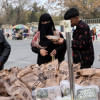Poverty rises sharply in multiple districts

Bangladesh is witnessing a concerning rise in poverty, leading to worsening food insecurity, according to a recent study by the Bangladesh Institute of Development Studies (BIDS).
The report highlights a sharp increase in poverty rates across multiple districts between 2022 and 2024, with food insecurity reaching alarming levels.
However, the BIDS could not identify the actual reason for the rise in poverty and worsening food insecurity, as the study was perception-based.
"The proportion of poor households increased to 26.43 percent in 2024 from 24.73 percent in 2022," said Mohammad Yunus, research director of the BIDS.
"…while the proportion of the extreme poor also rose from 6.06 percent to 6.63 percent during the same period," he said.
He made the comments while presenting a keynote on the findings of the study titled "Small area estimates of poverty 2022: trends and disparities in selected districts, 2024" at the BIDS conference room in Dhaka yesterday.
The BIDS study, conducted in collaboration with World Food Programme (WFP), found that the poverty headcount ratio has increased in key regions.
The highest poverty rates were recorded in Bandarban, Rangpur, and Sylhet. In Dhaka, while the overall poverty rate is lower, there has been a significant deterioration in perceptions of economic conditions among residents.
Urban areas witnessed a sharper rise in extreme poverty, reaching 8.16 percent in 2024, compared to 7.98 percent in 2022, whereas rural extreme poverty increased from 4.94 percent to 5.75 percent.
The report attributed the rise in poverty to inflationary pressures, climate change-induced disasters, and economic slowdowns following global disruptions.
The impact is more severe in rural areas, where the population living below the upper poverty line is higher than in urban areas.
A key indicator of the crisis is the Food Insecurity Experience Scale (FIES), which shows a worsening trend, according to the report.
The study found that the number of households experiencing moderate food insecurity has increased significantly compared to previous years.
Severe food insecurity has also risen, deepening the crisis for vulnerable populations.
Households are increasingly adopting negative coping strategies, such as reducing meal portions, skipping meals, and altering food consumption habits, the report added.
The study examined five districts—Bandarban, Dhaka, Khulna, Rangpur, and Sylhet—finding notable variations in poverty trends.
While Dhaka maintains relatively lower poverty rates, perception surveys indicate that many residents feel worse off compared to previous years.
In contrast, districts like Khulna and Rangpur have seen dramatic increases in poverty severity, with climate-induced factors such as riverbank erosion exacerbating the situation.
In Sylhet, Zakiganj emerged as a new poverty hotspot, with food insecurity affecting a growing number of households. The study warns that without immediate intervention, these regions may face deeper crises in the coming years.
Moderating the seminar, AK Enamul Haque, director general of the BIDS, stressed the urgent need for targeted policy interventions.
He highlighted the necessity of expanding social safety net programmes, strengthening food distribution mechanisms, investing in rural employment programmes, and addressing inflationary pressures that erode purchasing power.
With poverty and food insecurity worsening, policymakers must take swift and decisive action to prevent further deterioration of the situation and ensure the well-being of millions of vulnerable citizens, he added.
However, he acknowledged that the study was not conducted using statistical methods but was instead a perception-based study, where the government, non-government organisations, and other institutions cooperated to collect the information.
Takahiro Utsumi, head of research at the World Food Programme Bangladesh, said they have partnered with European statistics experts and the BIDS to refine small-area poverty estimation.
"Our estimates, based on the 2022 Household Income and Expenditure Survey, need updates due to economic downturns and shocks affecting households," he said, adding, "Understanding recent poverty trends is crucial for effective policymaking."
He also stated that government agencies must use these insights while planning for 2025 and beyond.
"This study is not a replacement for official estimates but serves as a critical reference for policy discussions and humanitarian interventions," he added.

 For all latest news, follow The Daily Star's Google News channel.
For all latest news, follow The Daily Star's Google News channel. 










Comments